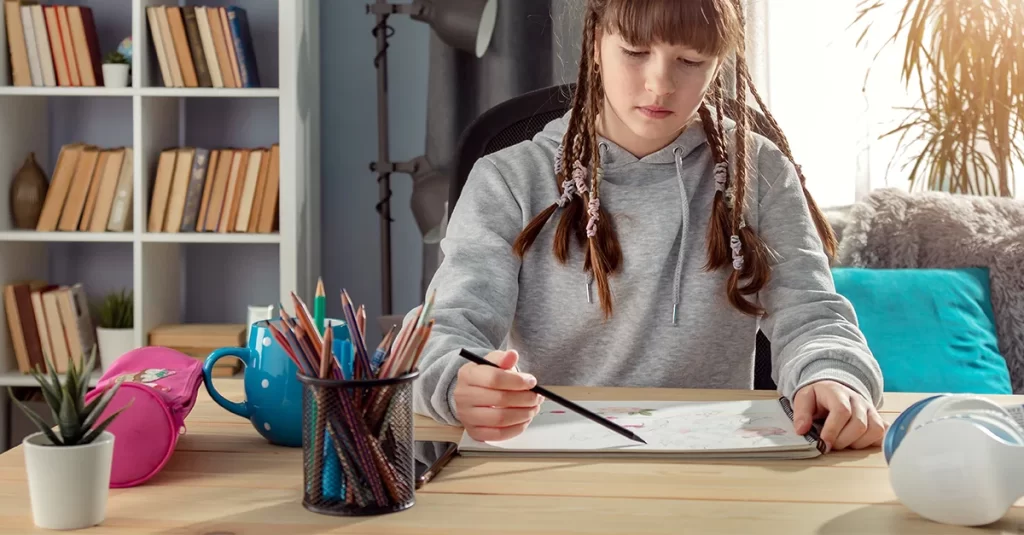Some students with attention-deficit/hyperactivity disorder (ADHD) come roaring into the school system like little ADHD bullet trains, their symptoms as obvious as their eye color. It’s much easier to manage ADHD with early intervention, so in a way, these kids are the lucky ones.
But sometimes ADHD symptoms go unnoticed or get misinterpreted as unruly behavior or laziness. These kids can get labeled as bad students or troublemakers, which can have tragic, long-term consequences for their success as adults.
It’s never too late to spot ADHD in students and it’s possible—even likely—that some of your students may remain undiagnosed into middle school and beyond. Let’s look at how ADHD might manifest in older children and what you can do to help support these kids in your classroom.
Disclaimer: This article is intended for educational purposes only. It should not be considered a substitute for professional medical advice. It is recommended to consult with a qualified healthcare professional for personalized guidance, accurate assessment and diagnosis, and appropriate treatment.
Older students with ADHD have many of the same symptoms as younger ones, but they can manifest differently.
Middle and high schoolers with ADHD may seem unmotivated, exhibit emotional immaturity, and have trouble staying organized.
Ways to support your ADHD students include giving them plenty of feedback, reducing the number of things they need to keep track of, and offering alternative assignments.
ADHD symptoms tend to evolve as kids get older. A significant number of students remain undiagnosed well into middle school. Sometimes ADHD symptoms in new 8th graders that weren’t apparent to their teachers in younger grades.
Puberty may exacerbate ADHD symptoms
Some scientists believe that puberty can exacerbate ADHD symptoms, but little research has supported this. What is clear is that puberty coincides with a surge in emotions and a higher need to fit in with peers, which can affect how these kids behave. Teenage years are difficult for any student; add ADHD to the mix and things can get truly challenging.
Older students with ADHD may:
1.Show a lack of focus in some areas, but not always in others
2.Forget things like due dates and study materials
3.Be disorganized and have trouble sticking to a schedule
4.Experience difficulty completing tasks
5.Fidget or be easily distracted
6.Seem self-absorbed
7.Be extremely sensitive to failure, criticism, or rejection
8.Engage in risk-taking behavior and show poor decision-making skills
6 signs of ADHD in students
Older students with ADHD have many of the same problems as younger kids, like forgetfulness, difficulty following instructions, zoning out, or being disruptive. But some of the “textbook” symptoms teachers recognize in younger students aren’t so apparent by the time they reach middle school.

With teens, it’s also a lot easier to misinterpret ADHD symptoms as laziness, defiance, or troublemaking. This might be because older students with ADHD don’t always consistently behave the way we expect kids with ADHD to behave. For example, they may need help writing a two-page essay about American history on time or get distracted during presentations, but have no problem focusing on a video game for hours or learning everything there is to know about their latest hobby.
It’s important to remember that middle school and high school is when students with ADHD can start to exhibit signs of comorbidities like depression and anxiety.
1. Trouble staying organized
This hallmark symptom of ADHD typically follows kids into their teenage years. Like younger kids with ADHD, teenagers may forget important dates, lose books or notes, or come to school without their glasses or gym clothes. Some students may even “give up” at this point, especially if they’ve never had help learning organizational strategies. Outwardly, this can look like they don’t care about school and aren’t invested in doing well.
In some cases, organizational problems become evident at this age, when kids are expected to manage their schedules without help from a parent.3
2. Lack of focus
School gets more complicated and involved in middle school and into high school, and children with ADHD can have a hard time keeping up. “In eighth grade, the discussions tend to be a little longer, or the questions tend to be a little more involved,” says York. Students with ADHD, he says, “just can’t get past that first thing before they sort of drift off or get distracted.”
3. Lack of motivation and apathy
Middle-schoolers and teenagers with ADHD may lack motivation in some areas but not others. Researchers believe that apathy and lack of motivation happen because people with ADHD have deficiencies in the reward-processing part of the brain. In simpler terms, it’s tough for a teenager with ADHD to stay motivated to do well in school when there are no immediate rewards for success.4
For example, a student with ADHD who loves art may perform brilliantly in art class because they gain emotional and mental satisfaction from that activity. But that same kid might perform terribly in a math class simply because the subject bores them, and there’s no immediate reward for doing well.
4. “Not living up to their potential”
ADHD students tend to struggle as school gets more difficult and workloads increase. Especially gifted or twice-exceptional (2e) kids, used to cruising through earlier grades, can seem like they’re not living up to their full potential when they have trouble meeting the higher demands on their executive functions.
5. Risk-taking behavior
In older students, impulsivity may not be as pronounced in a classroom setting as it can be for younger children. But especially at the high school level, they may be more susceptible to dangerous risk-taking outside of the classroom.
Typical risk-taking behaviors of ADHD students include:
Experimenting with drugs and alcohol
Risky sexual behavior
Reckless driving
This puts kids with ADHD at greater risk of addiction, teen pregnancy, injury, or even death.4
6. Emotional immaturity
Middle school and high school students with ADHD can sometimes seem woefully behind their peers in terms of emotional maturity. This is backed up by science—some researchers think people with ADHD are years behind their peers and may not reach the emotional maturity of a typical 21-year-old until their late 20s or early 30s.
In other words, teenagers with ADHD may continue to have inappropriate emotional outbursts long after other kids in the same age group have learned to cope with problems intellectually instead of emotionally.
“The biggest thing is to reduce the number of material items they need to keep track of or make them available in more than one place,” says York. He suggests keeping extra copies of textbooks in class so that if a student leaves one at home, another one is always available.
Break down assignments and offer alternatives
Try breaking up assignments into smaller pieces. Instead of assigning a complete essay, have students submit an outline before the final project to ensure they’re on track.
Provide different options for students to show they know the material. Besides essays, you could offer an oral report, an online quiz, or creating a comic book or other artistic project about the material.
Implementing these changes doesn’t just benefit your ADHD students; it fosters different modes of learning in all of them and makes for more engaging lessons.
ADHD teen pointing at a hand-drawn map, representing an alternative assignment supporting ADHD school kids.
High school
Help students create their routine
Routines are paramount at this age. Your high school students need to be able to set a schedule and stick to it, whether that’s getting to class on time every day or completing homework. Even at this age, kids with ADHD may benefit from receiving a class calendar that contains important dates and regular reminders to consult that calendar.
Start creating your routine: Help your students write down what they want to accomplish on certain days using sticky notes, phone reminders, or a calendar.

Pro tip! Try the daily focus feature on the Inflow app!
Find ways to ease boredom
Some kids with ADHD have an easier time focusing at a standing desk. Boredom is an ADHD teen’s enemy—try to present assignments enthusiastically and in an interesting way.
Add gamification techniques like a point system into your lesson plan to encourage friendly competition.
Need inspiration? Check out these motivation hacks for people with ADHD for ideas on gamification and reward systems you could use in the classroom.
Reward students for desired behavior
Help them stay on task by rewarding them for good work turned in on time (for a teenager, this can be verbal praise). If they need a quiet place to complete their work, it can be helpful to recommend them for tutoring or a supervised study period.
Support at any age
Seek accommodations for ADHD symptoms
An individualized education program can help you know which students need extra support in the classroom, but not every kid has one. York says he will provide support for any child with ADHD symptoms, regardless of their diagnosis status. “They will get the same accommodations, even if they’re not legally required.”
Additionally, the Inflow app has ADHD coaching services available that could help your student develop methods for goal-setting and time management, and provide accountability outside the classroom.
Monitor mental health and seek support when needed.
It’s also important to be on the lookout for symptoms of depression and other comorbidities in older children with ADHD. If you think your student is engaging in dangerous behavior or is at risk for self-harm or suicide, immediately connect that student with your school’s mental health services or the nurses office.

